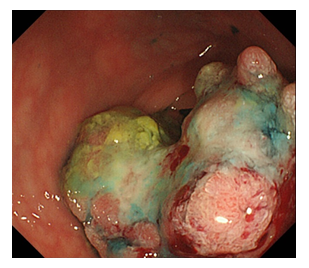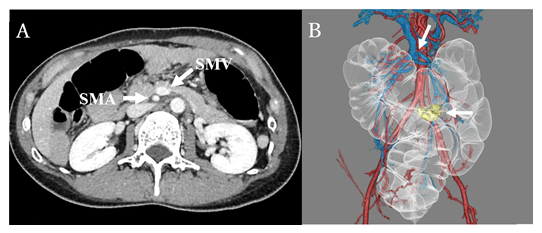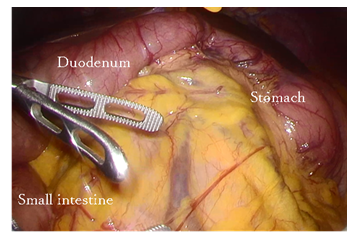Laparoscopic Surgery for Colon Cancer with Intestinal Malrotation: A Case Report and Review of the Literature in Japan
Article Information
Manabu Yamamoto MD1*, Kazuhito Sakata MD1, Hiroko Yano MD1, Tomonobu Gion MD1, Yohei Tominaga MD1, Hiroyuki Kobayashi2, Masazumi Tuneyoshi MD3
1Department of Surgery, Fukuoka Sanno Hospital, Fukuoka, Japan
2Department of Gastroenterological Internal Medicine, Fukuoka Sanno Hospital, Fukuoka, Japan
3Department of Pathology, Fukuoka Sanno Hospital, Fukuoka, Japan
*Corresponding Author: Manabu Yamamoto MD, Department of Surgery, Fukuoka Sanno Hospital, Momochi-hama 3-6-45, Fukuoka 814-0001, Japan
Received: 14 February 2021; Accepted: 26 February 2021; Published: 12 March 2021
Citation: Manabu Yamamoto, Kazuhito Sakata, Hiroko Yano, Tomonobu Gion, Yohei Tominaga, Hiroyuki Kobayashi, Masazumi Tuneyoshi. Laparoscopic Surgery for Colon Cancer with Intestinal Malrotation: A Case Report and Review of the Literature in Japan. Archives of Clinical and Medical Case Reports 5 (2021): 296-302.
View / Download Pdf Share at FacebookAbstract
Colorectal cancer with intestinal malrotation is very rare, while intestinal malrotation is one of congenital anomaly that is rare in adults. We thus report a case of sigmoid colon cancer with intestinal malrotation treated by laparoscopic surgery. A 39-year-old woman was admitted to our hospital with constipation. A colonoscopy revealed the sigmoid colon tumor. Three-dimensional abdominal enhanced computed tomography showed that small and large intestines occupied the right- and left-side of the abdominal cavity, respectively. Her diagnosis was the sigmoid colon cancer with nonrotation type of intestinal malrotation, and she underwent laparoscopic sigmoidectomy. There have been 43 cases reports of colorectal cancer with intestinal malrotation who underwent laparoscopic surgery in Japan medical literatures. Colorectal cancer was in the right-side in 69.8% of these cases, although that in the left-side is generally more common. Three-dimensional abdominal enhanced computed tomography angiography can reveal vascular anatomic anomalies to allow laparoscopic surgery to be performed safety.
Keywords
Colorectal cancer; Intestinal malrotation; Laparoscopic surgery
Colorectal cancer articles; Intestinal malrotation articles; Laparoscopic surgery articles
Colorectal cancer articles Colorectal cancer Research articles Colorectal cancer review articles Colorectal cancer PubMed articles Colorectal cancer PubMed Central articles Colorectal cancer 2023 articles Colorectal cancer 2024 articles Colorectal cancer Scopus articles Colorectal cancer impact factor journals Colorectal cancer Scopus journals Colorectal cancer PubMed journals Colorectal cancer medical journals Colorectal cancer free journals Colorectal cancer best journals Colorectal cancer top journals Colorectal cancer free medical journals Colorectal cancer famous journals Colorectal cancer Google Scholar indexed journals cancer articles cancer Research articles cancer review articles cancer PubMed articles cancer PubMed Central articles cancer 2023 articles cancer 2024 articles cancer Scopus articles cancer impact factor journals cancer Scopus journals cancer PubMed journals cancer medical journals cancer free journals cancer best journals cancer top journals cancer free medical journals cancer famous journals cancer Google Scholar indexed journals Intestinal malrotation articles Intestinal malrotation Research articles Intestinal malrotation review articles Intestinal malrotation PubMed articles Intestinal malrotation PubMed Central articles Intestinal malrotation 2023 articles Intestinal malrotation 2024 articles Intestinal malrotation Scopus articles Intestinal malrotation impact factor journals Intestinal malrotation Scopus journals Intestinal malrotation PubMed journals Intestinal malrotation medical journals Intestinal malrotation free journals Intestinal malrotation best journals Intestinal malrotation top journals Intestinal malrotation free medical journals Intestinal malrotation famous journals Intestinal malrotation Google Scholar indexed journals cryoglobulins articles cryoglobulins Research articles cryoglobulins review articles cryoglobulins PubMed articles cryoglobulins PubMed Central articles cryoglobulins 2023 articles cryoglobulins 2024 articles cryoglobulins Scopus articles cryoglobulins impact factor journals cryoglobulins Scopus journals cryoglobulins PubMed journals cryoglobulins medical journals cryoglobulins free journals cryoglobulins best journals cryoglobulins top journals cryoglobulins free medical journals cryoglobulins famous journals cryoglobulins Google Scholar indexed journals Laparoscopic surgery articles Laparoscopic surgery Research articles Laparoscopic surgery review articles Laparoscopic surgery PubMed articles Laparoscopic surgery PubMed Central articles Laparoscopic surgery 2023 articles Laparoscopic surgery 2024 articles Laparoscopic surgery Scopus articles Laparoscopic surgery impact factor journals Laparoscopic surgery Scopus journals Laparoscopic surgery PubMed journals Laparoscopic surgery medical journals Laparoscopic surgery free journals Laparoscopic surgery best journals Laparoscopic surgery top journals Laparoscopic surgery free medical journals Laparoscopic surgery famous journals Laparoscopic surgery Google Scholar indexed journals treatment articles treatment Research articles treatment review articles treatment PubMed articles treatment PubMed Central articles treatment 2023 articles treatment 2024 articles treatment Scopus articles treatment impact factor journals treatment Scopus journals treatment PubMed journals treatment medical journals treatment free journals treatment best journals treatment top journals treatment free medical journals treatment famous journals treatment Google Scholar indexed journals CT articles CT Research articles CT review articles CT PubMed articles CT PubMed Central articles CT 2023 articles CT 2024 articles CT Scopus articles CT impact factor journals CT Scopus journals CT PubMed journals CT medical journals CT free journals CT best journals CT top journals CT free medical journals CT famous journals CT Google Scholar indexed journals surgery articles surgery Research articles surgery review articles surgery PubMed articles surgery PubMed Central articles surgery 2023 articles surgery 2024 articles surgery Scopus articles surgery impact factor journals surgery Scopus journals surgery PubMed journals surgery medical journals surgery free journals surgery best journals surgery top journals surgery free medical journals surgery famous journals surgery Google Scholar indexed journals Colon Cancer articles Colon Cancer Research articles Colon Cancer review articles Colon Cancer PubMed articles Colon Cancer PubMed Central articles Colon Cancer 2023 articles Colon Cancer 2024 articles Colon Cancer Scopus articles Colon Cancer impact factor journals Colon Cancer Scopus journals Colon Cancer PubMed journals Colon Cancer medical journals Colon Cancer free journals Colon Cancer best journals Colon Cancer top journals Colon Cancer free medical journals Colon Cancer famous journals Colon Cancer Google Scholar indexed journals hemangioma articles hemangioma Research articles hemangioma review articles hemangioma PubMed articles hemangioma PubMed Central articles hemangioma 2023 articles hemangioma 2024 articles hemangioma Scopus articles hemangioma impact factor journals hemangioma Scopus journals hemangioma PubMed journals hemangioma medical journals hemangioma free journals hemangioma best journals hemangioma top journals hemangioma free medical journals hemangioma famous journals hemangioma Google Scholar indexed journals
Article Details
Abbreviations:
CT- Enhanced computed tomography; SMA- Superior mesenteric artery; SMV- Superior mesenteric vein; IMV- Inferior mesenteric vein
1. Introduction
Intestinal malrotation tract is rare, and occurs in around 1 in 6000 live births. Colorectal tumors are common, with an incidence of more than 1 million new cases each year [1, 2]. When the two are combined it can create a diagnostic conundrum that may delay diagnosis and inevitably lead to disease progression. Malrotation of the intestinal tract is believed to stem from incomplete rotation and fixation of the bowel during development. In normal embryogenesis, week 5 signifies a 270°clockwise rotation of the gut around the superior mesenteric artery (SMA) following enlargement of the midgut portion, then, at week 10, the tract normally attaches to the posterior aspect of the abdominal cavity. If this process is interrupted at any point, then intestinal malrotation will result [3]. Malrotation typically presents in the first month of life - it is rare to find cases or complications from childhood disease in adults.
Patients with colorectal cancer has gradually increased, and colorectal cancer for women and men were ranked as the second and third in 2007 Japan, respectively [4]. Recently, the laparoscopic procedures for colon cancer has been commonly undergone. However, laparoscopic procedures of colorectal cancer with intestinal malrotation has not yet been established due to rare incidence of intestinal malrotation, and it is difficult to understand the abnormal anatomies.
This case, and 42 cases who had been previously performed laparoscopic surgery in Japan, highlight the need to review new findings and three-dimensional computed tomography angiography is used to safe and effective to treat with colorectal cancer by laparoscopic surgery.
2. Case Presentation
A 39-year-old Japanese woman was admitted to our hospital with constipation. A Borrmann type II tumor located at the 30 cm from the anal verge by the colonoscopy (Figure 1).

Figure 1: Preoperative examinations. Gastrointestinal endoscopy revealed the tumor at the sigmoid.
A tumor was indicated as thick walls by abdominal enhanced computed tomography (CT), and located in the left-side of the abdominal cavity. Lymph nodes swelling at the paracolic region was present in the absence of distant metastatic lesions. The superior mesenteric vein (SMV) was located on the left side of the SMA in the three-D-CT (Figure 2A), and that the inferior mesenteric vein (IMV) flowed to the SMV (Figure 2B). Consequently, laparoscopic sigmoidectomy was scheduled.

Figure 2: (A) Enhanced CT revealed a superior mesenteric artery (SMA) in the right-side and a superior mesenteric vein (SMV) in the left-side. (B) 3D-CT revealed inferior mesenteric vein (IMV) flow to the SMV (arrow) and the tumor in the sigmoid colon (yellow).
At the laparoscopy, the small and large intestine occupied in the right-side and the left-side of the abdominal cavity, respectively. The marked tumor was found in the sigmoid colon. The ligament of Treitz could not found (Figure 3), and the cecum and ascending colon were not fixed to the retroperitoneum. The patient was diagnosed with sigmoid colon cancer with nonrotation type of intestinal malrotation. We performed sigmoidectomy with D3 lymph node dissection.

Figure 3: At the laparoscopy, the most of small intestine occupied the right-side of the abdominal cavity with no existence of the Treitz ligament.
Histopathological examination revealed a well-differentiated tubular adenocarcinoma, and tumor invaded the serosa with three lymph node metastases (pT4aN1bM0; pStage IIIB). The patient was discharged on the 23th postoperative day. At the time of this writing, she is doing well without recurrence at 21 months postoperatively.
3. Discussion
The intestinal malrotation induces midgut volvulus or intestinal obstruction in infants, and most cases of intestinal malrotation present within several months after birth [5]. It is difficult to diagnose of intestinal malrotation in adults, due to remain asymptomatic, in addition, colorectal cancer with intestinal malrotation is very rare. Most cases of intestinal malrotation are found by chance when they were examined abdominal examinations or surgeries in adults.
From 2007 to 2020, 43 cases of colorectal cancer with intestinal malrotation including the present case, underwent laparoscopic surgery in Japan (Table 1) [6].
|
|
(2007~2020) |
||
|
Age (n=39) |
67.2±14.2 (39~90) |
68a |
|
|
Sex |
Male |
32 (74.4) |
(55.8) |
|
Female |
11 (25.6) |
(41.2) |
|
|
Location |
Appe |
1 11 30 (69.8) 12 6 |
(0.3) (7.4) (31.8) (14.3) (9.8) |
|
C |
|||
|
A |
|||
|
T |
|||
|
D |
0 6 13 (30.2) 1 6 |
(4.7) (25.4) (68.2) (11.9) (26.2) |
|
|
S |
|||
|
Rs |
|||
|
R |
|||
|
Type of malrotation (n=34) |
Non rotation |
24 |
|
|
Malrotation |
9 |
||
|
Reserved rotation |
1 |
||
Indicated in the references, age; n=39, type; n=34; (): the percentage in parentheses; a: Case treated in 2007 (Multi-institute registry of Large Bowel Cancer in Japan)
Table 1: Background in the 43 patients, who had undergone a laparoscopic surgery for colorectal carcinoma with intestinal malrotation.
We reviewed the available literature on this topic in Japan, and found that the rate of patients with colorectal cancer with intestinal malrotation occurred in the right- and left-side were 69.8% and 30.2%, respectively. Surprisingly, the rate of colorectal cancer in the right-side with intestinal malrotation was higher than that of left-side. In 2007 Japan, the rate of colorectal cancers in the right-side and left-side was 31.8% and 68.2%, respectively [7]. Commonly, the rate of colorectal cancer in the left-side is predominant to that in the right-side. The reason for the right-side predominance in the colorectal cancer with intestinal malrotation is unknown. However, since the midgut portion is the cause of the intestinal malrotation, the colon cancer may also be located at the midgut portion, from the cecum to the transverse colon.
The malrotation types are the most common of the four types, including nonrotation, malrotation, reversed malrotation and paraduodenal hernia [8]. Indeed, in the current review, 24 of 34 cases were nonrotation type.
As the surgical approach, laparoscopic surgery is more recently performed, while open surgery was more common previously. In 2007, Yamamoto et al. firstly reported that laparoscopic surgery could be performed for ascending colon cancer with nonrotation type of intestinal malrotation [9], while 43 cases have undergone laparoscopic surgery from 2007 until now in Japan. The laparoscopic surgery has been rapidly adopted for the treatment of colorectal cancers with lymph node dissection, and the quality of laparoscopic procedure is progressing in many countries. It is difficult to safely perform vascular ligations and lymph node dissection by laparoscopic surgery because most cases with intestinal malrotation have arterial abnormalities [10]. Therefore, an exact understanding of the vascular anomalies is preoperatively important to perform safety in the laparoscopic surgery. Three-D-CT angiography is useful for examine abnormalities of the artery, when laparoscopic surgery for colorectal cancer with intestinal malrotation is performed.
The majority of patients with colorectal cancer with intestinal malrotation are male, and the cancer is more frequently present in the right-side. If intestinal malrotation is diagnosed preoperatively, three-D-CT angiography would be used to understanding of the vascular anomalies, due to perform safety in the laparoscopic surgery.
Competing Interests
The authors declared that they have no competing interests.
Consent for Publication
The informed consent for publication and presentation was obtain from the patient.
Funding
This work was no supported from any funding.
Authors’ Contribution
MY participated in the drafting of the manuscript. KS, HY, TG, YT and HK acquired data, and MT diagnosed pathological examinations. All authors read and approved the final version of manuscript.
Acknowledgment
The authors have no competing of interests to declare. This manuscript was approved by the ethics committee in the hospital.
References
- Amaral L, Quintaniha R, Bernardo L, et al. Intestinal malrotation in the elderly. Am Surg 75 (2009): 631-633.
- Haggar FA, Boushey RP. Colorectal cancer epidemiology: incidence, mortality, survival, and risk factors. Clin Colon Rectal Surg 22 (2009): 191-197.
- Durkin ET, Lund DP, Shaaban AF, et al. Age-related differences in diagnosis and morbidity of intestinal malrotation. J Am Coll Surg 206 (2008): 658-663.
- Center for cancer control and information services. Cancer information service, in: Project Cancer Statistics, National Cancer Center, Japan, 2017, Available: http://ganjoho.jp/en/publish/statistics/short pred.html.
- Maxson RT, Franklin PA, Wagner CW. Malrotation in the older child: surgical management, treatment, and outcome. Am Surg 61 (1995): 135-138.
- Nakatani K, Tokuhara K, Sakaguchi T, et al. Laparoscopic surgery for colon cancer with intestinal malrotation in adults: two case reports and review of literatures in Japan. Int J Surg Case Rep 38 (2017): 86-90.
- Japan Society for Cancer of the Colon and Rectum. Multi-institutional registry of large bowel cancer in Japan. Cases treated in 33 (2007).
- Wang CA, Welch CE. Anomalies of intestinal rotation in adolescents and adults. Surgery 54 (1963): 839-855.
- Yamamoto J, Fuchino Y, Harimura T, et al. A laparoscopic right hemicolectomy performed on a patient with ascending colon cancer accompanied by adult intestinal malrotation. Jpn J Gastroentrol Surg 40 (2007): 1960-1965.
- Nishida K, Kato T, Lefor T, et al. Laparoscopic resection of sigmoid colon cancer with intestinal malrotation: a case report. Int J Surg Case Rep 34 (2017): 77-80.


 Impact Factor: * 3.1
Impact Factor: * 3.1 CiteScore: 2.9
CiteScore: 2.9  Acceptance Rate: 11.01%
Acceptance Rate: 11.01%  Time to first decision: 10.4 days
Time to first decision: 10.4 days  Time from article received to acceptance: 2-3 weeks
Time from article received to acceptance: 2-3 weeks 
